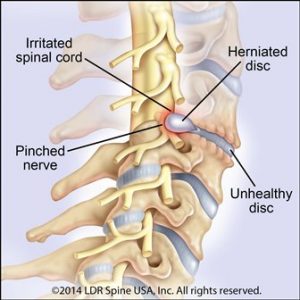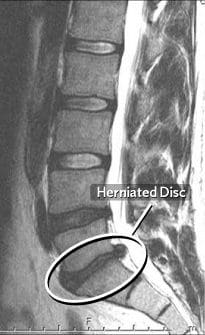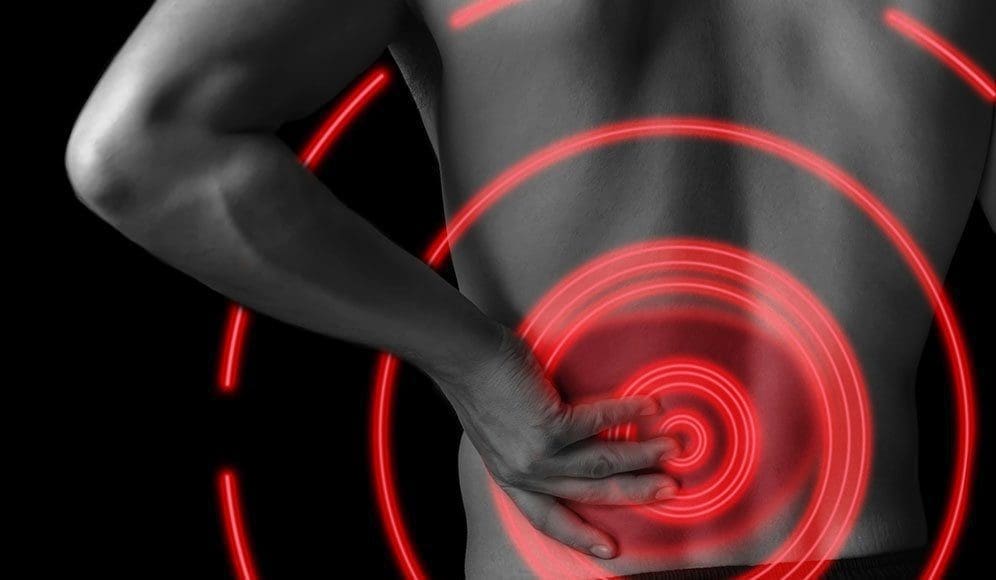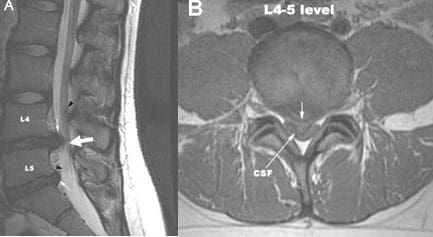Sometimes called a ruptured or slipped disc, your lower back pain often occurs due to a herniated disc in the lumbar spine. In fact, it’s one of the most common causes of low back pain, in addition to sciatica.
Between 60 and 80 percent of people will experience back pain at least once throughout their lifetime. A high proportion of these individuals will have low back and leg pain brought on by a herniated disc.
Most people feel better with just a few weeks or months of non-surgical treatment though a disc can sometimes be very debilitating. Surgical therapy can also help alleviate discomfort and disc pain if symptoms are not resolved.


Table of Contents
Nonsurgical Treatment of Herniated Discs
After the first injury, the doctor may recommend cold treatment and drugs.
- During the first 24 to 48 hours, cold treatment helps to reduce pain by decreasing blood flow, muscle soreness, and swelling. Never use ice or cold directly to skin; instead wrap item or the ice pack in a towel and then apply for more than 15 minutes.
- Medications may include an anti-inflammatory to lessen swelling, a muscle relaxant to calm anxiety, and a pain-killer to relieve intense but alleviate pain (severe pain).
- Mild to moderate pain may be treated with anti inflammatory anti inflammatory drugs (NSAIDs). These work by relieving pain and swelling.
Please discuss use with your physician.
- Usually heat treatment can be applied. Blood circulation increases to heat and relax soft tissues. Higher blood flow will help to flush out toxins that may accumulate in tissues as a consequence of muscle spasm and intervertebral disc injury. Never use heat directly to skin ( just like chilly); rather, wrap the heat source in a thick towel for no longer than 20 minutes.
Spinal Injection
Leg weakness is developing, or if leg pain is intense, the doctor may prescribe an anabolic steroid injection. Anti-inflammatory medication is put by an epidural steroid injection into the space near the nerves on your lumbar spine. Before beginning this therapy you need to discuss this option with your doctor and ask.
Physical Therapy
The doctor may recommend physical therapy. The doctor’s orders are transmitted to the physical therapist by prescription. Physical treatment includes a mixture of treatments to reduce pain and improve flexibility. Heat and ice therapy stretching, and grip are a few examples, but your therapist may work together to develop the best treatment plan for the pain and symptoms.
Surgical Treatment of a Lumbar Herniated Disc
If symptoms does not relieve spine surgery is known as. Persistent pain, leg fatigue, or lack of function requires additional evaluation. Rarely, does a lumbar herniated disc cause bowel/bladder incontinence or groin/genital numbness, which demands immediate medical attention.
In case surgery is recommended, constantly ask what outcomes you can expect and the goal of the surgery. You have to understand all details of what’s being advocated, and do not hesitate to get a second opinion. Surgery is a big decision, so you odn’t wish to rush in to it.
To alleviate nerve pressure and leg pain, surgery generally involves a discectomy (elimination of all or part of the intervertebral disc).
In addition, by removing some of the bone covering the nerve the surgeon may need to access the herniated disc. This procedure is called a laminotomy.
These processes can be done using minimally invasive methods. Minimally invasive spine surgery doesn’t require large incisions, but instead uses apparatus like endoscope and a microscope during the surgery and tiny specialized instruments and cuts.
Can You Prevent a Lumbar Herniated Disc?
Earlier we advised you that a cause of a lumbar disc is aging, and that can’t be avoided by us. Does that mean that you can not do anything to prevent a lumbar herniated disc?
Of course not. There are numerous factors which are also to take care of your spine, and within your hands, observe your posture, do not smoke, make healthy food choices, exercise, and use body mechanics, especially whenever you’re lifting something.
They’re usually healthy actions you can take to try and prevent lower back pain, although doing all of those things won’t ensure that you never get a lumbar herniated disc.
The scope of our information is limited to chiropractic and spinal injuries and conditions. To discuss options on the subject matter, please feel free to ask Dr. Jimenez or contact us at 915-850-0900 . 
By Dr. Alex Jimenez
Additional Topics: Sciatica
Lower back pain is one of the most commonly reported symptoms among the general population. Sciatica, is well-known group of symptoms, including lower back pain, numbness and tingling sensations, which often describe the source of an individual’s lumbar spine issues. Sciatica can be due to a variety of injuries and/or conditions, such as spinal misalignment, or subluxation, disc herniation and even spinal degeneration.
<
div class=”video-container”>
<
iframe src=”https://www.waxwinginteractive.com/manage/admin/playembed.php?vid=5&client=1350 scrolling=”no” border-width=”0″>

TRENDING TOPIC: EXTRA EXTRA: New PUSH 24/7Â®ï¸ Fitness Center
Post Disclaimer
Professional Scope of Practice *
The information herein on "Treatment Options for Herniated Discs | Sciatica Chiropractor" is not intended to replace a one-on-one relationship with a qualified health care professional or licensed physician and is not medical advice. We encourage you to make healthcare decisions based on your research and partnership with a qualified healthcare professional.
Blog Information & Scope Discussions
Welcome to El Paso's Premier Wellness, Personal Injury Care Clinic & Wellness Blog, where Dr. Alex Jimenez, DC, FNP-C, a Multi-State board-certified Family Practice Nurse Practitioner (FNP-BC) and Chiropractor (DC), presents insights on how our multidisciplinary team is dedicated to holistic healing and personalized care. Our practice aligns with evidence-based treatment protocols inspired by integrative medicine principles, similar to those found on this site and our family practice-based chiromed.com site, focusing on restoring health naturally for patients of all ages.
Our areas of multidisciplinary practice include Wellness & Nutrition, Chronic Pain, Personal Injury, Auto Accident Care, Work Injuries, Back Injury, Low Back Pain, Neck Pain, Migraine Headaches, Sports Injuries, Severe Sciatica, Scoliosis, Complex Herniated Discs, Fibromyalgia, Chronic Pain, Complex Injuries, Stress Management, Functional Medicine Treatments, and in-scope care protocols.
Our information scope is multidisciplinary, focusing on musculoskeletal and physical medicine, wellness, contributing etiological viscerosomatic disturbances within clinical presentations, associated somato-visceral reflex clinical dynamics, subluxation complexes, sensitive health issues, and functional medicine articles, topics, and discussions.
We provide and present clinical collaboration with specialists from various disciplines. Each specialist is governed by their professional scope of practice and their jurisdiction of licensure. We use functional health & wellness protocols to treat and support care for musculoskeletal injuries or disorders.
Our videos, posts, topics, and insights address clinical matters and issues that are directly or indirectly related to our clinical scope of practice.
Our office has made a reasonable effort to provide supportive citations and has identified relevant research studies that support our posts. We provide copies of supporting research studies upon request to regulatory boards and the public.
We understand that we cover matters that require an additional explanation of how they may assist in a particular care plan or treatment protocol; therefore, to discuss the subject matter above further, please feel free to ask Dr. Alex Jimenez, DC, APRN, FNP-BC, or contact us at 915-850-0900.
We are here to help you and your family.
Blessings
Dr. Alex Jimenez DC, MSACP, APRN, FNP-BC*, CCST, IFMCP, CFMP, ATN
email: coach@elpasofunctionalmedicine.com
Multidisciplinary Licensing & Board Certifications:
Licensed as a Doctor of Chiropractic (DC) in Texas & New Mexico*
Texas DC License #: TX5807, Verified: TX5807
New Mexico DC License #: NM-DC2182, Verified: NM-DC2182
Multi-State Advanced Practice Registered Nurse (APRN*) in Texas & Multi-States
Multistate Compact APRN License by Endorsement (42 States)
Texas APRN License #: 1191402, Verified: 1191402 *
Florida APRN License #: 11043890, Verified: APRN11043890 *
License Verification Link: Nursys License Verifier
* Prescriptive Authority Authorized
ANCC FNP-BC: Board Certified Nurse Practitioner*
Compact Status: Multi-State License: Authorized to Practice in 40 States*
Graduate with Honors: ICHS: MSN-FNP (Family Nurse Practitioner Program)
Degree Granted. Master's in Family Practice MSN Diploma (Cum Laude)
Dr. Alex Jimenez, DC, APRN, FNP-BC*, CFMP, IFMCP, ATN, CCST
My Digital Business Card
RN: Registered Nurse
APRNP: Advanced Practice Registered Nurse
FNP: Family Practice Specialization
DC: Doctor of Chiropractic
CFMP: Certified Functional Medicine Provider
MSN-FNP: Master of Science in Family Practice Medicine
MSACP: Master of Science in Advanced Clinical Practice
IFMCP: Institute of Functional Medicine
CCST: Certified Chiropractic Spinal Trauma
ATN: Advanced Translational Neutrogenomics






 Again, We Welcome You.
Again, We Welcome You.
Comments are closed.